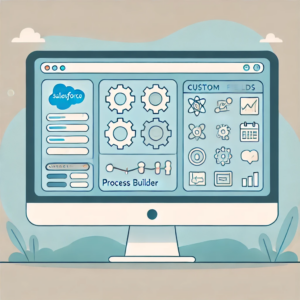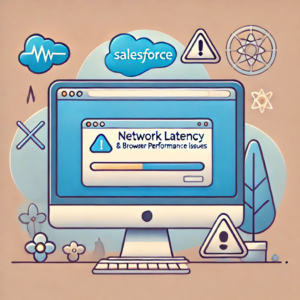
If you’ve ever experienced sluggish page loads or slow response times when using Salesforce Lightning, you’re not alone. Although the platform is strong, occasionally performance problems cause consumers to question, “Why does Salesforce Lightning load so slow?” From heavy customizing and complicated pages to massive data volumes and external connectors, several elements lead to this issue. We will investigate the typical causes of sluggish Lightning loading times and discuss doable fixes to improve your Salesforce experience on this blog.
1. Heavy Customizations and Complex Pages
One of the most significant reasons why Salesforce Lightning loading can feel slow is the amount of customization and complexity in the pages. With custom objects, components, and automation tools like Process Builder or Flow—which Salesforce provides—great flexibility is provided. All these extra features, however, can cause the platform to load slowly—especially if your company has highly customized layouts, reports, and dashboards.
Salesforce has to render all custom elements every time a page loads, which can create major delays especially when users have sophisticated reports loaded or a lot of data. Rich interface of Salesforce Lightning, meant to offer a more engaging experience, might add extra load time if the underlying code is complicated or ineffective.
2. Large Data Volumes and Inefficient Queries
Salesforce is designed to handle large volumes of data, but sometimes, the sheer size of data sets can slow down the Lightning loading process. Should your company have massive databases containing case histories, opportunities, or client records—that would cause delayed loading of Lightning pages.
This can be aggravated by ineffective searches or reports that grab too much data without appropriate filtering. As Salesforce gets and analyzes the data, a report with many records or a list view with ineffective filters will slow page load speeds.
3. Network Latency and Browser Issues
Sometimes, Salesforce Lightning loading issues have little to do with the platform itself and more to do with external factors such as network latency or browser performance. The time it takes for Salesforce pages to load may be much affected by slow or erratic internet connection. Likewise, performance problems could result from the browser you are using not being totally compatible with Salesforce Lightning.
Older browsers might not handle JavaScript and other technologies as effectively as more recent browsers or support all of the capabilities of Salesforce Lightning, for example. Slowness on pages may also arise from network congestion or a bad connection between your device and Salesforce’s servers.
4. Salesforce Maintenance and Updates
Salesforce is always changing with fresh enhancements, fixes, and features. New upgrades or continuous maintenance can occasionally momentarily compromise the performance of the platform. Because Salesforce Lightning depends on cloud infrastructure, updates, maintenance windows, or transient server problems might cause slowdowns or reduced performance.
5. Salesforce Integration with External Applications
Many organizations integrate Salesforce with other third-party applications and services to enhance their workflows. These connectors can slow down Salesforce Lightning even if they are quite helpful. Integration can create extra loading times when Salesforce handles data from outside databases or syncing with marketing automation solutions.
6. Browser Caching and Performance Settings
By storing static files including pictures, JavaScript, and CSS locally, browser caching significantly enhances performance. On the other hand, a non-regular clearance of the browser cache could lead to corruption or outdatedness, therefore compromising Salesforce Lightning’s performance.
Salesforce Lightning is a powerful platform designed to provide users with a modern, feature-rich experience. Poor Lightning load times can be caused, nevertheless, by difficulties including excessive customizations, big data quantities, poor network connections, and connectors. Whether it’s from complicated modifications, big data sets, or outside events, knowing the underlying causes of poor performance will help you maximize your Salesforce instance and guarantee that users experience betterment.
How to Fix Salesforce Lightning Slow Loading Issues
Luckily, there are various solutions to fix the performance problems driving delayed loading of your Salesforce Lightning experience. You can hasten things by following these guidelines:
1. Optimize Page Layouts and Reduce Complexity
Review your dashboards and page layouts first to be sure they are not overburdened with too many fields or components. Load times can be greatly lowered by eliminating pointless fields, custom components, and lessening of the records shown on a page. Simplify the design and just include the necessary data for every page using Lightning App Builder.
2. Optimize Reports and Dashboards
Limit the number of records included in list views and reports. To cut the data being loaded, you can create filters; alternatively, you could think about using aggregated data in dashboards to cut the record count Salesforce must produce. If big data sets are required, consider breaking out reports into smaller pieces or using Salesforce’s batch processing tools.

3. Improve Apex Code Efficiency
If your Salesforce instance relies heavily on custom Apex code, ensure that it is optimized. Review and maximize SOQL searches to guarantee they only retrieve the required data; steer clear of doing pointless operations inside triggers or classes. This will assist avoid Salesforce delayed loading brought on by ineffective code and cut processing times.
4. Use the Lightning Performance Tools
Salesforce has built-in tools meant to assist you find performance bottlenecks: the Lightning Performance Analyst and Salesforce Lightning Inspector. Whether it’s a specific component, page, or report, these tools will provide you understanding of what is holding down your Salesforce Lightning load times. Once found, you can act to maximize those particular locations.
5. Clear Cache and Browser Data
Frequent clearing of the cache, cookies, and history from your browser will help to guarantee that past data is not slowing down anything. Check also that you are running the most current version of your browser. Be careful to turn on certain browsers, such as Google Chrome and Firefox, which have built-in tools to enhance efficiency when utilizing online apps.
6. Check Salesforce’s Trust Status
Always check the Salesforce Trust page to see if there are any ongoing performance issues or maintenance activities that could be affecting your instance. Should maintenance windows or outages exist, this could help to explain poor loading times; all you can do is wait till Salesforce fixes the problem.
7. Use the Salesforce Lightning Experience Best Practices
Salesforce’s extensive collection of best practices for the Lightning Experience might assist to raise performance standards. This covers maximizing Lightning components, allowing lazy loading for parts, and lowering of API call count. Following these rules helps you to guarantee that your Lightning experience stays quick and effective..
8. Upgrade Your Hardware or Network
If you continue to experience slow loading despite optimizing your Salesforce settings, you may want to investigate your local hardware or network setup. A slow computer or a bad internet connection might aggravate Salesforce Lightning delayed loading times. Performance can be much improved by upgrading your gear or network connection.
So, End story:
While it’s frustrating to deal with slow Salesforce Lightning load times, understanding the common causes and applying the right fixes can help get your system running at full speed. Whether it’s optimizing your page layouts, improving your Apex code, or clearing your browser cache, these simple steps can significantly improve your experience.

